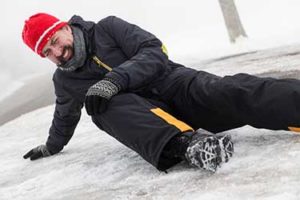
They further claim that their injury would not have happened if the defendant had taken care of the premises properly.
Their failure to take care of the premises was the largest determining factor in their injury.
This presumes, however, that the plaintiff had a legal right to occupy the premises.
If, for instance, a plaintiff goes on to private property and injures his ankle, then the defendant can claim that the plaintiff could have avoided the injury simply by staying off the property.
In this article, we’ll take a look at some of the elements that go into proving a valid slip and fall claim against a negligent defendant.
The Role of Negligence in Slip and Fall Claims
In order to prove negligence in a court of law, a plaintiff must be able to show that:
- The defendant owed a duty of care to the plaintiff,
- The defendant breached that duty of care,
- Injuries resulted from that breach.
For slip and fall claims, the law centers around the question of when the duty of care is breached. On the one hand, a property owner does owe a duty of care to those who are invited on his or her premises. On the other hand, a property owner cannot be expected to foresee every situation that may result in injury.
A plaintiff must, thus, be able to prove that the property owner either:
- Caused the dangerous condition,
- Knew about the dangerous condition,
- Should have known about the dangerous condition.
When a plaintiff can prove any of those three elements, they have a valid slip and fall claim.
Examples of Valid Slip and Fall Claims
- A woman goes to a plaza and gets out of her car. The parking lot, however, has not been plowed. She slips and falls on the ice. In a case like this, it is expected that owner of the strip mall would be responsible for clearing out the parking lot of snow and ice. In other words, they should have known that the parking lot would be potentially dangerous to customers of the plaza.
- A man walks into a gas station. The area around the drink dispensers and coffee has some liquid spilled on the ground. He slips on the liquid. In this case, those managing the gas station should have known or did know that the area was very prone to dangerous slip hazards.
- Person A invites Person B over to their home. Person A has neglected to clear the steps of ice and snow. Person B falls down the steps injuring themselves. In this case, Person A knew that they were going to have company, knew about the dangerous condition, and neglected to do anything about it.
Valid slip and fall claims require that an at-fault party be to blame for an accident. In other words, they had to know that the dangerous condition existed or known that it was likely that the dangerous condition would exist.
Call a Yakima, Washington Personal Injury Attorney Today
If you think you have a valid slip and fall claim, feel free to call the personal injury attorneys at Kapuza Lighty PLLC for a free consultation. We can discuss your case and go over the elements that you will need to prove it.
